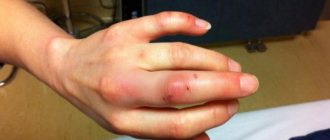Homemade preparations have always been welcomed by housewives. To this day, they are an indispensable attribute not only on the holiday table, but are also ideal for an everyday dinner.
Despite the variety of canned products on supermarket shelves, homemade pickles leave no one indifferent. Homemade canned food not only has an excellent taste, but is also rich in vitamins that are so necessary for humans.
There are many recipes for preparing various canned foods. During the cold months, berries and mushrooms collected in the summer months are popular. But it will be possible to enjoy their great taste only if certain rules are followed, the implementation of which is a necessity for all types of preservation.
Beginning housewives must first become familiar with the various methods and some nuances, so that even if they make minor mistakes, they will know what to do if a jar of mushrooms swells, if mold appears, or if the color of a particular product changes.
Why do banks explode?
Now we will find out the main reasons why rolled up jars of mushrooms become bombed: • poor washing of mushrooms before rolling; • non-compliance with the exact recipe. Especially if you add little vinegar; • poorly sterilized and washed jars. In this case, there may be microbes on the surface of the cans, which in the future will become the main cause of undesirable consequences; • poor-quality closure with lids or poor rolling of iron lids. As a result, air enters the can, which is the main cause of the explosion; • canned jars of mushrooms are kept warm, which is absolutely not allowed.
How to avoid exploding mushroom jars
We have listed the main reasons for can explosions. Now let's look at how you can avoid such undesirable consequences. If the problem is sterilization, then it is necessary to sterilize already filled jars. You can simply put them in the oven and heat them to 100 degrees. After about 15 minutes you can close them with pre-sterilized lids. You should also remember that peppers and mushrooms are considered the most finicky foods. Therefore, such preparations need to be given special attention. When canning fried chanterelles, for example, you need to spare no oil. They must literally swim in it. Otherwise, there is a very high probability that the banks will swell. After you have closed the lid of the jar, make sure that it fits tightly and that there is no free space left. Also, special attention should be paid to the seaming machine. If it is old or simply rolled up poorly, then air may get in, which will subsequently be the main cause of the explosion. If your jar of mushrooms exploded because it was in a warm place, then next time you need to be sure to put all the jars in a cool place. The ideal option would be the following: for the first two days, put the jars in the refrigerator.
Why did the jar of mushrooms swell? What to do if a jar of mushrooms swells?
If this happened, then probably the jars were simply poorly pasteurized, which means some microbes remained. It will simply be unpleasant to eat such products later. There is one more nuance. If a jar of mushrooms “exploded” just a few hours after seaming, then they can be re-rolled. To do this, you need to re-sterilize the jars, then transfer all the contents and boil well. After all, mushrooms are a product that must be eaten very carefully. Especially if they have already been processed.
Well, if a lot of time has passed since the explosion, then it is better to throw them away immediately. After all, health is much more important.
Symptoms of milk mushroom poisoning
Milk mushroom poisoning can manifest itself with various symptoms after a certain time.
Regardless of the type of poisoning by these mushrooms, the main symptom is gastroenterocolitis. The only difference will be in the latent period:
- with a short latent period, it takes from 30 minutes to 2 hours from the moment of eating mushrooms to the development of the clinical picture of poisoning;
- with a long latent period from two to 48–72 hours from the moment of eating mushrooms.
There are cramps and pain in the abdomen, nausea, vomiting, intestinal colic and diarrhea. Everything is accompanied by loss of water and salts and the development of dehydration and electrolyte disturbances.
Basic Rules
- Keeping canned foods in warm places. A sufficiently high temperature stimulates various chemical processes.
- Storage on an uninsulated balcony. When frozen, the volume in jars increases, which can cause glass containers to crack. Jam or preserves quickly become sugary in the cold.
- Storage for too long. Over time, slow chemical processes will begin to occur that will affect the quality of the products.
- Store for no more than two years.
- Maintain the desired temperature from 0 to + 15 ° C.
- Use only sterilized utensils.
- Rinse all products thoroughly.
Harvesting mushrooms
Particular attention should be paid to storing mushrooms for the winter. With proper preparation, they can be stored for as long as possible and will be a great addition to dinner.
Before sealing, already filled jars with lids should be sterilized. They are sterilized in water heated to 40 degrees for about 40-50 minutes. If the water manages to boil away during this time, then you need to add boiling water, otherwise the temperature difference will cause the glass jar to burst. Next, you should immediately seal it, check the quality and then cool it at room temperature.
If the rules are not fully followed, this will lead to spoilage of the canned food, and all housewives will have to face a common problem, who subsequently do not know what to do if the jar of mushrooms is swollen or the lid comes off completely.
A little history
Botulism in mushrooms is deadly
The cause of botulism today, as a rule, is low-quality homemade canned mushrooms. Until the mid-twentieth century, when there was no large-scale preparation (there were no suitable containers, special rolling machines and tin lids), the source of the terrible disease was spoiled fish (dried and salted), as well as sausage. By the way, the name of the disease comes from the Latin word “botulus”, which means “sausage”.
History has preserved an episode when in Belgium three dozen musicians, invited (ironically) to play at a funeral, almost went to the next world themselves after treating themselves to homemade ham. However, three still could not be saved, and doctors took a long time to nurse several more people. But it was then that doctors managed to produce the first immune serum, which subsequently saved many hundreds of people affected by botulism.
Mistakes when canning
The most common mistake is insufficient sterilization, which subsequently contributes to the development of microbes in the product. As a result, gas will begin to be released over time, the presence of which leads to an increase in pressure in the container.
Another factor that influences lid bloating is its quality. Air may get trapped at the junction with the can, as a result of which swelling should also be expected.
And if the lid on a jar of mushrooms does swell during storage, then further storage of the product is not recommended, since this indicates poor quality of the contents. Typically, this phenomenon can be observed within a few days after sterilization.
Treatment of milk mushroom poisoning
If started in a timely manner, treatment is not particularly difficult.
General principles of treatment for poisoning with these mushrooms:
- stopping the entry of poison into the body;
- removing poison from the body (gastric and intestinal lavage, enterosorbents);
- symptomatic therapy (most often antiemetics);
- method of forced diuresis (infusion therapy and prescription of diuretics).
Thus, when collecting and preparing mushrooms, you should follow some simple rules:
How to test for botulism?
If such a nuisance does happen and a marriage occurs, then you need to know what to do and what to do if the jar of mushrooms is swollen. Before the product is reprocessed, the formation of botulism must be determined. You should press on the swollen lid. If it is dented, then a new washing and digestion of the mushrooms is allowed, and if the lid does not dented, then the process of botulism has definitely begun in the jar, and in this case it is necessary to throw away all the contents. This product will no longer be suitable for use.
But it should be remembered that mushrooms are a product whose consumption requires special care.
Prevention
Eat only those mushrooms that you are confident in because you picked them and cooked them yourself. In a restaurant or at a party, refrain from eating mushrooms, since according to statistics, it is precisely such festive feasts that result in mushroom poisoning.
Remember that the toxin is extremely stable, and if, due to your negligence, it ended up in a jar, neither vinegar, nor salt, nor time will destroy it. Therefore, be especially careful at the stage of harvesting mushrooms, follow all recommended conditions.
What to do if jars of mushrooms explode
Many housewives, before and now, are engaged in home canning. And, although there is now no shortage of such goods in stores, there is nothing better than vegetables rolled at home. In production, a large amount of vinegar is necessarily added to the brine, and it is impossible to drink it. Moreover, they sell not canned, but pickled vegetables. And what could be better than a mug with it in the morning, after the holiday. Therefore, every woman has her own unique pickling recipe, which, as a rule, is passed down from generation to generation.
But when canning cucumbers, the problem of brine cloudiness arises. This can happen with several cans or with an entire batch of freshly sealed canned goods. What should I do to avoid this?
Consequences of the disease
Practice shows that after a severe form of the disease, even with qualified therapy, recovery is slow, over several weeks. Residual signs may be felt for several months.
More often, the consequences of botulism make themselves felt when restoration measures are not carried out in a timely manner. We are talking about the following conditions:
- tracheobronchitis and acute respiratory failure,
- aspiration pneumonia,
- mumps purulent type,
- myositis and myocarditis.
It is worth knowing about the side effects of therapy, as the body’s response to toxoid. Such reactions include serum sickness and anaphylactic shock.
Lactic acid or botulism?
If the brine is cloudy, but the lids are not swollen, the formation of lactic acid (milk fungus) has begun in the canned food. It's not scary. It only means that the fermentation process has begun.
This type of acid is the only natural preservative. As it accumulates, it stops the development of other bacteria. And for the solution to become transparent again, it is enough to put the jars in a cold place: a cellar or refrigerator. The turbidity will settle to the bottom in a white coating. The cucumbers, of course, will not be crispy and will lose their attractive appearance. But for a salad or pickle, they are quite suitable.
If the lids are swollen and the brine becomes cloudy, then there is nothing to do - you need to throw out the canned food. Because it is life-threatening. Bloating is a 100% sign of botulism. The causative agent of this disease is microbes – anaerobes. They develop only in the absence of oxygen (canned food) and affect the central nervous system, which can be fatal.
In the natural environment, spores of these bacteria live in the soil, with which they end up on vegetables. Microbes die only at temperatures above 120 degrees, and at 100 degrees they are viable for several hours. Large amounts of salt and vinegar are absolutely safe for them. You can fight them only by boiling the product.
Getting rid of cloudy sediment
- You cannot reduce or increase the proportions of the components of the salting solution. If you add more dill, the brine will become cloudy. Reducing the amount of salt or vinegar will have the same effect. Or the absence of the latter. In addition to its unappetizing appearance, it can be hazardous to health.
- Jars that are packed too tightly or a lot of different herbs (currants, dill, etc.) can cause a cloudy brine to appear. Experienced housewives, in addition to cucumbers, add tomatoes or peppers to the jars - in this case the liquid will remain transparent
- A proven way to get rid of cloudy brine is boiling. To do this, you need to open the jars with cloudy brine, wash them, sterilize them, remake the solution and preserve the vegetables again. Boiled liquid needs to be poured twice
- In addition to cucumbers, a cloudy solution can occur when fermenting vegetables: cabbage, carrots and the same cucumbers. In this case it is the norm. After all, lactic acid works. When pickling mushrooms, you can also encounter this problem. Method of struggle: pour out the mushroom solution, boil it, adding peppercorns, bay leaves and salt. Let it simmer, cool and pour over the mushrooms again.
To sum it up, we can say this: do not ignore the rules. By saving time now, you will spend much more of it later. This is the best case scenario. And at worst, you risk your health and that of your loved ones.
Therefore, when starting to make canned food, thoroughly wash and sterilize the jars, rinse the vegetables only under running water, and add the required brine components in the specified proportions. To seal, use an autoclave. And you won’t face the problem of cloudy brine.
How to properly salt saffron milk caps so they don’t go sour
To prevent salted saffron milk caps from fermenting, it is necessary to take the pickling procedure seriously from the very beginning, strictly following all preparation instructions.
First of all, if dry salting is not used, it is necessary to carefully free the mushrooms from plant debris and especially particles of earth or sand using water. But you should remember that you shouldn’t soak the saffron milk caps in water for a long time.
Many housewives use exclusively hot salting to prevent saffron milk caps from turning sour. That is, boil the mushrooms before salting or at least pour boiling water over them.
Salt must be added at the rate of 1.5 cups per 10 liter bucket of saffron milk caps.
Since salt is the main preservative, it is better to slightly overdo it than to undersalt it. The salty solution will prevent the mushrooms from turning sour. And if it is too salty, then when eating the saffron milk caps, you can lightly rinse them in cold running water.
The pickling container should be enameled, glass, ceramic or wooden. Under no circumstances should you use metal utensils.
Finally, the most important thing is that you must ensure that when pickling, all mushrooms are covered head-to-head with brine. Place them in the prepared container as tightly as possible, sprinkle with salt and spices and press until abundant juice is released. If suddenly the natural mushroom juice is not enough, then add brine and be sure to put pressure on top. The press must be selected so that its weight is enough to ensure that all the mushrooms disappear below the liquid level.
In room conditions, pickled saffron milk caps can stand for no more than a day for the fermentation process to begin. Then they are moved to a cold place, otherwise they will certainly turn sour.
While under pressure, it is necessary to constantly monitor the color of the brine. It should have a reddish tint and an attractive mushroom aroma. If the color has changed and turned gray, this means that the saffron milk caps could have turned sour, so it is necessary to urgently take rescue measures.











